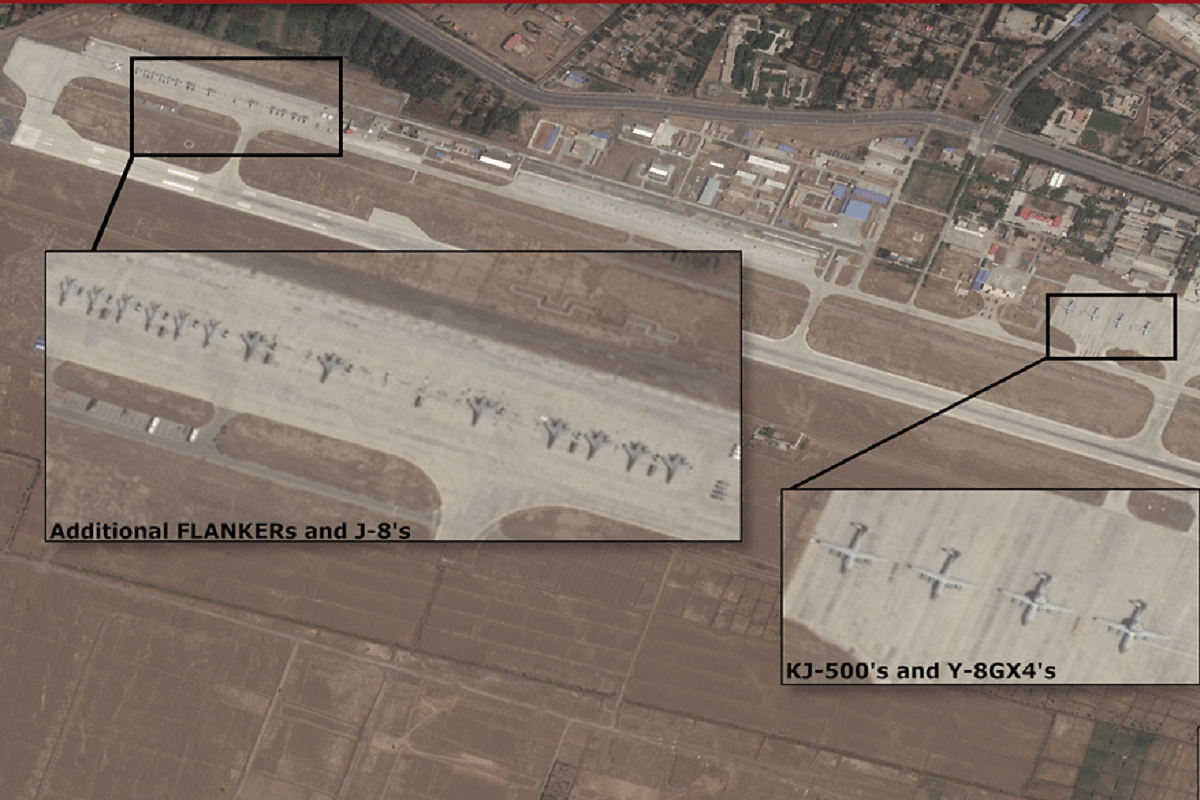News Brief
Chinese Air Force Deployed At Three Bases In Tibet, Its Capability To Launch Multiple High Altitude Missions Weak: IAF Chief
- China has been improving infrastructure at its airbases on the Tibetan Plateau and this exercise has only gathered pace since May last year, when the military standoff in eastern Ladakh began.

Chinese deployments at Hotan Air Base.
The People's Liberation Army Air Force (PLAAF) of China remains deployed at three airbases on the Tibetan Plateau, the newly appointed chief of the Indian Air Force, Air Chief Marshal V R Chaudhari, has said in a press conference ahead of the Air Force Day.
"The situation on the Line of Actual Control is that the Chinese Air Force is still present on three air bases on their side of the LAC. We are fully deployed and prepared on our side," the Air Force Chief said.
Air Chief Marshal Chaudhari also noted that the capability of the PLAAF to mount multiple high-altitude missions would remain weak.
"China's capability to launch multiple high altitude missions would remain weak," the new IAF Chief has been quoted by ANI as saying.
China has been improving infrastructure at its airbases on the Tibetan Plateau, and this exercise has only gathered pace since May last year, when it diverted thousands of troops from an exercise towards the Line of Actual Control (LAC), triggering a tense military standoff in parts of eastern Ladakh that continues at multiple friction points.
For instance, at the Ngari Gunsa airbase (which also serves as a civilian airport), located just 200 km away from the Pangong Lake, China is building 12 hardened shelters to shield its aircraft from enemy missiles and bombs. The expansion of the base, which began sometime in early 2020, continued throughout the military standoff in eastern Ladakh.
Large-scale earth work, ongoing from April 2020, was seen in a satellite image dated 15 May, next to the 4,500m runway of the airbase. Back then, reports said it could be a “second taxi-track or a secondary tarmac”.
China has also finished the upgrade to the main surface-to-air missile site adjacent to the Lhasa Gonggar airport, which also serves as a major base for the PLAAF in Tibet. The airbase is located at a distance of around 200 km from Arunachal Pradesh and 350 km from Sikkim.
In 2020, during the standoff in eastern Ladakh, increased Chinese air activity had been detected in Tibet by the IAF.
“During summer, there are usual exercises. But at this time, we have noticed more than usual deployment,” the then Chief of Air Staff, Air Chief Marshal R K S Bhadauria, has been quoted as saying.
China’s increased fighter deployments were visible at the Hotan Air Station, one of PLAAF’s major bases lying north of Ladakh in Xinjiang.
The PLAAF, according to Air University's China Aerospace Studies Institute (CASI), normally deploys around 12 unidentified variants of Flanker (possibly J-16) at its base in Hotan. However, as an assessment published by CASI in June 2020 pointed out, based on satellite images dated 14 June, China deployed “an additional 24 aircraft” at this airbase.
"Normally, the PLAAF maintains roughly twelve unidentified FLANKER variants at Hotan Air Station and an unknown number of CH-4 Unmanned Aerial Vehicles. To augment these forces already in theater, the PLAAF deployed a number of additional assets in early June 2020. Unverified handheld photography from early June 2020 and overhead electro-optical imagery from 14 June 2020 shows that the PLAAF has deployed an additional 24 aircraft to Hotan," the report by CASI read.
Support Swarajya's 50 Ground Reports Project & Sponsor A Story
Every general election Swarajya does a 50 ground reports project.
Aimed only at serious readers and those who appreciate the nuances of political undercurrents, the project provides a sense of India's electoral landscape. As you know, these reports are produced after considerable investment of travel, time and effort on the ground.
This time too we've kicked off the project in style and have covered over 30 constituencies already. If you're someone who appreciates such work and have enjoyed our coverage please consider sponsoring a ground report for just Rs 2999 to Rs 19,999 - it goes a long way in helping us produce more quality reportage.
You can also back this project by becoming a subscriber for as little as Rs 999 - so do click on this links and choose a plan that suits you and back us.
Click below to contribute.
Latest